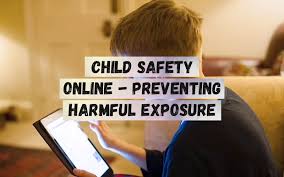
Addressing the Problem of Children Being Exposed to Harmful Content on the Internet
In today's digital age, children have become an integral part of the internet. However, along with the advancement of technology and the convenience of the internet, there is also the risk of exposure to harmful content. To protect children from the negative effects, adults need to play an important role in helping children to select and avoid unhealthy content on the internet.
11/15/20244 min read

The internet has become an integral part of modern life, providing children with countless opportunities for learning, entertainment, and social interaction. However, it also brings significant risks, including exposure to harmful or age-inappropriate content. From violent videos to explicit material, cyberbullying, and misleading information, these dangers pose serious threats to the well-being and development of young minds. Addressing this issue requires a collaborative effort involving parents, educators, policymakers, and tech companies. Below, we explore the root causes and practical solutions to mitigate the risks.
Understanding the Problem
1. Types of Harmful Content
Children can encounter numerous forms of inappropriate content online, including:
Explicit material: Sexual or violent imagery that is unsuitable for their age.
Cyberbullying: Harassment or abusive behavior on social media and messaging platforms.
Hate speech and radicalization: Content that promotes prejudice, discrimination, or extremist ideologies.
Misinformation: Fake news or pseudoscientific claims that can distort a child’s worldview.
Age-inappropriate advertisements: Ads for gambling, alcohol, or other adult-focused industries.
2. How Children Access Harmful Content
Children are often exposed to such content accidentally or intentionally through:
Social media platforms.
Streaming services with inadequate content controls.
Search engines that do not filter results properly.
Online games with unmoderated chat features.
Clicking on malicious links in emails or pop-ups.
The Impact of Harmful Content
Exposure to inappropriate content can have long-term consequences for children, including:
Emotional distress: Anxiety, fear, or confusion caused by violent or graphic material.
Behavioral issues: Increased aggression or desensitization to violence.
Distorted perceptions: Unrealistic expectations about relationships, body image, or the world.
Reduced academic focus: Time spent navigating harmful content can detract from learning activities.
Vulnerability to exploitation: Grooming or manipulation by predators targeting children.
Solutions to Protect Children Online
1. Parental Involvement
Parents play a crucial role in safeguarding their children from harmful online experiences. Key steps include:
Open communication: Talk to children about the dangers of the internet and teach them to recognize inappropriate content.
Supervised internet use: Encourage screen time in shared spaces rather than private bedrooms.
Set boundaries: Implement rules about when and how the internet can be used.
Teach critical thinking skills: Help children evaluate the credibility of online information.
2. Use of Parental Control Tools
Technology can assist parents in monitoring and restricting access to harmful content:
Enable filters and safe browsing modes on search engines like Google.
Set up parental controls on devices, apps, and streaming platforms.
Use monitoring software to track online activity and screen time.
3. Education and Digital Literacy
Schools and communities should prioritize teaching children about responsible internet use:
Digital literacy programs: Educate children about online safety, privacy, and recognizing harmful content.
Workshops for parents: Equip caregivers with the tools and knowledge to manage their children’s online presence.
4. Government Regulation
Policymakers can implement and enforce laws to protect children online:
Mandate age verification systems for platforms hosting adult content.
Require social media companies to moderate harmful content more effectively.
Penalize platforms that fail to comply with child protection standards.
5. Accountability for Tech Companies
Tech companies have a moral responsibility to ensure their platforms are safe for children:
Content moderation: Invest in AI and human moderators to flag and remove harmful content.
Kid-friendly features: Develop child-specific versions of platforms, such as YouTube Kids.
Transparency: Clearly communicate how user data is used and what measures are in place to protect minors.
The Role of Collaboration
Effectively addressing harmful content requires collaboration between stakeholders:
Parents and schools should work together to create a consistent approach to online safety.
Governments and tech companies must cooperate to implement child protection laws and develop safer platforms.
Media and advocacy groups can raise awareness about the risks and promote best practices for online safety.
Conclusion
The internet is an invaluable tool for children but comes with significant risks that cannot be ignored. Exposure to harmful or age-inappropriate content can have profound effects on their mental health, behavior, and development. However, by fostering open communication, leveraging technology, educating children, and holding tech companies accountable, we can create a safer digital environment for the next generation. Ensuring children’s online safety is not just a parental responsibility—it is a societal imperative that requires collective action. By working together, we can protect young minds while still allowing them to explore the vast benefits of the digital world.








Here
Here


Explore
Engaging tips for kids and tablet usage.
Learn
Play
123-456-7890
© 2024. All rights reserved.
